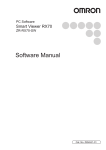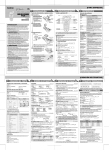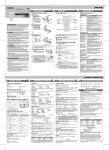Download midi LOGGER Software USER'S MANUAL
Transcript
GL200
midi LOGGER Software
USER’S MANUAL
MANUAL NO. APS(GL200)-UM-151
Contents
1. Main Features................................................................................................................................. 1
2. System Requirements.................................................................................................................. 1
3. Installing the USB Driver............................................................................................................. 2
4. Connecting to a PC (Personal Computer). ............................................................................ 5
5. Installing the GL200 Application Software. ............................................................................ 6
6. Launching the Software............................................................................................................... 6
7. PC Connection Settings. ............................................................................................................. 7
8. Display Screens
8-1 Y-T (Main Screen)......................................................................................................................... 8
8-2 X-Y .............................................................................................................................................10
8-3 Digital ......................................................................................................................................... 11
8-4 Meter . ........................................................................................................................................12
8-5 Report.........................................................................................................................................13
8-6 CSV File Batch Conversion........................................................................................................ 14
8-7 Alarm...........................................................................................................................................15
8-8 Statistics/Log ............................................................................................................................. 15
8-9 Comment.................................................................................................................................... 15
8-10 Waveform Op............................................................................................................................ 16
8-11 Opening Data Captured to the PC............................................................................................ 18
8-12 Review PC (Waveform Display)................................................................................................ 20
8-13 Review PC (Digital Display)...................................................................................................... 21
8-14 Superimpose/Link..................................................................................................................... 22
8-15 Convert then Save.................................................................................................................... 22
8-16 Display in Excel......................................................................................................................... 22
8-17 XY between cursors.................................................................................................................. 23
9. Settings Screens
9-1 AMP Settings.............................................................................................................................. 24
9-1-1 Span Settings.................................................................................................................... 25
9-1-2 Scaling Settings................................................................................................................ 25
9-2 Data Capture Settings................................................................................................................. 26
9-2-1 Device Capture Settings................................................................................................... 27
9-2-2 PC Capture Settings......................................................................................................... 27
9-3 Trigger/Alarm Settings................................................................................................................ 28
9-3-1 Level Condition................................................................................................................. 29
9-3-2 Alarm Condition................................................................................................................. 30
9-3-3 Send Email when Alarm is Generated.............................................................................. 30
9-4 Report Settings........................................................................................................................... 31
9-5 Other Settings............................................................................................................................. 32
10. Operating Procedure
10-1 Capture Settings....................................................................................................................... 33
10-1-1 AMP Settings................................................................................................................... 33
10-1-2 Data Capture Settings..................................................................................................... 33
10-2 Start..........................................................................................................................................34
10-3 Displaying past data during a data capture operation............................................................... 34
10-4 Stop........................................................................................................................................... 35
10-5 Replay Data.............................................................................................................................. 35
1. Main Features
• A variety of display formats
Data can be viewed in Y-T, X-Y, Digital, Meter, and Report formats, on large, easy-to-read screens.
• Export to Direct Excel File Function
Captured data can be exported directly to an Excel file and displayed as graphs. Ready-to-use template files are
provided as standard for your convenience.
(Note: The Microsoft Excel program must be installed.)
• Thumbnail waveform display
Before replaying captured data, the waveforms can be checked by referring to the small images (thumbnails) provided
next to each file name. These thumbnails provide easy confirmation of the data before opening the file.
• The maximum and minimum values for all the channels can be checked at any time during data capture.
• Real-time calculation functions
During data capture and data replay operations, up to four calculation operations can be performed. The calculation
results can be viewed as a waveform.
• Send Email when Alarm is Generated
When an alarm is generated, this function enables a notification email to be sent to a mobile phone, for example,
thereby ensuring that a check can be performed if required.
(Note: An email sending environment is required.)
• Printing function, Screen save function
The waveform screen can be printed out on a printer, and screen copies saved to a file.
(Note: To use the printing function, the device must be connected to a printer.)
• Help function
Help buttons that provide simple descriptions of the various functions are assigned to each of the menu setting items
to provide ease of use.
2. System Requirements
Make sure that the computer on which you plan to install the software meets the following requirements.
Item
OS
CPU
Memory
HDD
Display
Other
System requirements
Windows 2000, XP
Pentium 4: 1.7 GHz or higher
256 MB or more
20 MB additional space is required for installing software
1024 x 768 resolution or higher
65535 colors or more (16-bit or more)
USB port, CD-ROM drive (for installing from CD)
Microsoft Excel software (for the Export to Direct Excel File and Display in Excel functions)
CHECKPOINT
Even when using a PC that meets the system requirements, measurement data may not be captured correctly depending on the PC
status (e.g. running other applications or insufficient memory capacity in the storage media used). Exit all other applications before
capturing data to the internal hard disk.
3. Installing the USB Driver
This chapter describes how to install the USB driver.
Checking the version of your USB driver
This section describes how to view the version of the USB driver if it is already installed.
(1) Opening "Device Manager"
Select "Control Panel" g "System" g "Hardware" tab or right-click "My Computer", select "Properties" g "Hardware"
tab g "System Properties" window, and then click the "Device Manager" button.
(2) In the "Device Manager" window, open "USB (Universal Serial Bus) Controller". Confirm that "Graphtec DM/GL/WR
Series USB Driver" is shown. Right-click it and select "Properties".
(3) Updating the driver
Select the "Driver" tab and click the "Driver Details" button.
(4) Select [...\GTCUSBR.SYS] to view the version of the driver file.
Installing the USB Driver
This section describes how to install the USB driver.
(1) Insert the User's Guide CD-ROM provided as a standard accessory into the PC's CD-ROM drive.
(2) Connecting the GL200 to the PC.
Connect the GL200 to the PC using the USB cable, and then turn the power on.
(3) Install the USB driver. The installation procedure depends on the type of operating system and whether or not you
are installing the driver for the first time.
• Windows XP: Driver software is to be installed for the first time.
Driver software is already installed.
• Windows 2000:Driver software is to be installed for the first time.
Driver software is already installed.
Windows XP: Driver software is to be installed for the first time.
Installing the USB driver.
(1) Detecting the hardware
Connect the USB cable to the PC and GL200. The "Found New Hardware" message appears.
(2) Starting the wizard
In the "Found New Hardware Wizard" window, select "Install from a list or specific location (Advanced)" under "What
do you want the wizard to do?" and click "Next".
(3) In the "Please choose your search and installation options." window, select "Don't search. I will choose the driver to
install." and click "Next".
(4) In the "Select the device driver you want to install for this hardware." window, click "Have Disk".
(5) In the "Install from Disk" window, browse the CD-ROM under "Copy manufacturer's files from", select "USB DRIVER"
g "GTCUSBR.INF" and click "OK".
(6) In the "Select the device driver...." window, "Graphtec DM/GL/WR Series USB Driver" appears in the "Model" box.
Select it and click "Next".
(7) Installing the driver
Windows XP starts installing the driver. Depending on the OS settings, the following error message may be
displayed: "The software you are installing for this hardware: GL200 has not passed Windows Logo testing to verify
its compatibility with Windows XP." Click the "Continue" button to proceed with the installation.
(8) Completing installation
The "Completing the Found New Hardware Wizard" window appears. Click "Finish" to exit the wizard.
Windows XP: Driver software is already installed.
Updating the USB driver
(1) Opening "Device Manager"
Select "Control Panel" g"System" g "Hardware" tab or right-click "My Computer", select "Properties" g "Hardware"
tab g "System Properties" window, then click the "Device Manager" button.
(2) In the "Device Manager" window, open "USB (Universal Serial Bus) Controller". Confirm that "Graphtec DM/GL/WR
Series USB Driver" is shown. Right-click it and select "Properties".
(3) Updating the driver
Select the "Driver" tab and click "Update Driver".
(4) Starting the update wizard
The "Hardware Update Wizard" appears. Select "Install from a list or specific location (Advanced)" under "What do
you want the wizard to do?" and click "Next".
(5) In the "Please choose your search and installation options." window, select "Don't search. I will choose the driver to
install." and click "Next".
(6) In the "Select the device driver you want to install for this hardware." window, click "Have Disk".
(7) In the "Locate File" window, browse the CD-ROM, select "USB DRIVER" g "GTCUSBR.INF" and click "Open".
(8) Return to the "Select the device driver" window and click "Next".
(9) Installing the driver
Windows XP starts installing the driver. Depending on the OS setting, "The software you are installing for this
hardware: GL200 has not passed Windows Logo Testing to verify its compatibility with Windows XP" message may
appear. Simply click "Continue Anyway".
(10)Completing the installation
The "Completing the Hardware Update Wizard" window appears. Click "Finish" to exit the wizard.
Windows 2000: Driver software is to be installed for the first time.
Installing the USB driver
(1) Starting the wizard
Connect the USB cable to the PC and the GL200. The "Found New Hardware" wizard appears.
(2) In the "Found New Hardware Wizard" window, select "Search for a suitable driver for my device (Recommended)"
under "What do you want the wizard to do?" and click "Next".
(3) In the "Locate Driver File" window, select "CD-ROM drive" under "Optional search locations" and click "Next".
(4) Browse the CD-ROM, select "USB DRIVER" g "GTCUSBR.INF" and click "OK".
(5) "The wizard found a driver" message appears. Click "Next".
(6) Completing installation
The "Completing Found New Hardware Wizard" window appears. Click "Finish" to exit the wizard.
Windows 2000: Driver software is already installed.
Updating the USB driver
(1) Opening "Device Manager"
Select "Control Panel" g "System" g "Hardware" tab or right-click "My Computer", select "Properties" g "Hardware"
tab g "System Properties" window, then click the "Device Manager" button.
(2) In the "Device Manager" window, open "USB (Universal Serial Bus) Controller". Confirm that "Graphtec DM/GL/WR
Series USB Driver" is shown. Right-click it and select "Properties".
(3) Updating the driver
Select the "Driver" tab and click "Update Driver".
(4) Starting the update wizard
"Upgrade Device Driver Wizard" appears. Click "Next".
(5) In the "Install Hardware Device Drivers" window, select "Display a list of the known drivers for this device so that I
can choose a specific driver." under "What do you want the wizard to do?" and click "Next".
(6) In the "Select a Device Driver" window, click "Have Disk".
(7) In the "Locate File" window, browse the CD-ROM, select "USB DRIVER" g "GTCUSBR.INF" and click "OK".
(8) Return to the "Select a Device Driver" window and click "Next".
(9) In the "Start Device Driver Installation" window, click "Next".
(10)Completing installation
The "Completing the Upgrade Device Driver Wizard" window appears. Click "Finish" to exit the wizard.
4. Connecting to a PC (Personal Computer)
The GL200 is connected to a PC via a USB cable.
B connector
Note: When using a USB cable, a USB driver must be installed in the PC. Please see Section 3, "Installing the USB Driver" for the
installation procedure.
Connection Method
Use an A-B type USB cable to connect the GL200 to a PC.
A connector
B connector
5. Installing the GL200 Application Software
This chapter describes how to install the application software.
(1) Insert the User's Guide CD-ROM provided into the PC's CD-ROM drive.
(2) Click the Taskbar's Start button, and then click the Run... icon to open the "Run" window.
(3) Enter the CD-ROM drive name and \English\midi LOGGER Software\Setup.exe as the name of the file you wish to
open. If the disk is in drive D, for example, enter "D\English\ midi LOGGER Software\Setup.exe" in the box and then
click "OK" to launch the installer.
(4) Follow the instructions on the screen to continue with the installation.
Note: Be sure to observe the following points when connecting the GL200 to a PC.
•Do not connect any devices apart from a mouse or a keyboard to any of the other USB terminals on your PC.
•Set the PC's power-saving functions to Off.
•Set the Screen Saver to Off.
•Set the anti-virus software auto update and scan scheduler functions to Off. Also, set the Windows auto update and scheduler
functions to Off.
6. Launching the Software
Click the Taskbar's "Start" button g "Programs" g "midi LOGGER Software" to launch the application software. Once the
program has started up, the following screen is displayed.
7. PC Connection Settings
The GL200 is connected to a computer via USB to enable communication between the devices.
(1) Click the "Connect (F5)" button on the main menu to display the Connect screen.
(2) Click row "1:" to reverse the display color to blue, and then click the "Edit/Add" button.
Click the "Edit/Add" button
Click to reverse the color to blue
(3) Enter the name of the connected device, and then click the "OK" button. If a device name is not entered, it will
automatically be assigned the name "Device1".
Enter the device name
Click the "OK" button
(4) Click the "Connect" button to perform the connection to enable communication between the devices.
(5) Click the "Close (ESC)" button to close the Connect screen.
Click the "Connect" button to start the connection procedure.
Click the "Close (ESC)" button to close the Connect screen.
8. Display Screens
This chapter describes the various screens used in this software.
8-1 Y-T (Main Screen)
1
2
3
4
5
6
7
8
9
10
13
11
14
15
12
16
17
18
19
21
20
22
No.
Name
1
2
3
4
5
6
7
8
Connect (F5)
Review PC
CSV file batch conversion
Capture Settings
Start (F7)
Stop (F8)
Review Device
Print Screen
9
10
11
Save Screen
End
Simplified message area
Ref.
Page No.
Click this button to open the Connect screen.
p.7
Click this button to replay the data captured to the PC (personal computer).
p.20
Click this button to convert multiple GBD (binary data) files captured to the PC to CSV files.
p.14
Click this button to open the data capture settings screen.
p.24
Click this button to start data capture.
Click this button to stop data capture.
Click this button to replay the data captured to the device.
p.20
Click this button to print out a copy of the screen. Printing is performed at the printer that
has been selected as the default printer. If you change the printer, relaunch the software.
Click this button to save the displayed screen as a BMP file.
Click this button to exit the application.
The operating status is displayed here.
Description
Free Running
Armed
Recording...
Capture Ended
12
Capture Information
Stopped status. (not capturing data)
Awaiting trigger activation; data has not been captured.
Data capture status.
Data captured has ended. Click the "Stop" key.
Information is displayed here during a data capture operation.
Start Time
Capture Time
Allowable Time
Data capture start time.
The amount of time that has elapsed since the start of data capture.
The amount of time available for data capture. When the remaining
time is up, data capture stops at both the device and the PC.
Number
The number of data capture operations when Repeat Capture
has been specified.
Sampling Interval
The sampling interval.
PC Capture Destination The data capture destination at the PC.
No.
13
Name
Battery Information
Description
The device battery capacity is displayed here.
When the AC power supply is being used
Battery power: Full
Battery power: Medium
Battery power: Low
Battery power: Very low
14
Statistics/Log Display
15
Alarm
16
Cursors
17
Comment
18
19
Waveform Op.
Digital
20
21
Cursor Time
Y Axis Range
22
Waveform Graph
Ref.
Page No.
(blue, blue, blue)
(green, green, green)
(–, orange, orange)
(–, –, red)
(–, –, –)
Data capture stops if a capture operation is
being performed.
Click this button to display the results of statistical calculation performed during data
capture, and a log of the alarms generated.
Click this button to display the alarm output port status. If "Alarm Hold" has been selected,
the alarm can be cleared by clicking the "Alarm Clear" button.
Click these buttons to display the cursors during a data capture operation when the
device is in the Scroll Off status.
Click this button to enable a comment to be input above the desired CH waveform on the
waveform graph displayed during data capture.
Click this button to perform various settings for the waveform display.
The digital values are displayed in this area. Clicking on any of the CH numbers enables
the waveform for that channel to be hidden/displayed. The channels for which an alarm
has been generated are shown in red.
The cursor times are displayed during data capture when Scroll Off has been selected.
The Y axis scale for the waveform graph is displayed in this area. If "No Divisions" has
been selected for the "Waveform Op." screen, the Y-axis scales for up to a maximum of
four channels can be displayed.
The waveforms are displayed here.
p.15
p.15
p.15
p.16
The waveform on your computer screen may differ from the waveform displayed on the device's display screen. This is
because even though a slow sampling speed has been specified, the sampled data is being compressed for display.
The "Scroll" button is displayed on the Y-T screen during data capture. Use the "Scroll" button's On/Off functions to
display current data and past data.
When Scroll On has been selected, the waveform graph is scrolled so that the data at the right edge is the newest data.
When Scroll Off has been selected, the scrolling operation is halted and data that was captured in the past can be viewed
on the scroll bar.
Scroll On
Scroll (Scroll On/Off selection button)
Scroll Off
Scroll bar
8-2 X-Y
Up to four combinations can be handled, and the X-Y channels can be specified freely.
2
3
4
1
5
6
No.
Name
1
2
X-Y Waveform Graph
Range
3
4
ON/OFF
X Axis/Y Axis Channel
Settings
Cursor Information
Display Cursor
5
6
Description
The X-Y waveforms are displayed here.
These buttons specify display of the scale values for the channels selected for the X and
Y axes.
Click these buttons to specify the display as ON or OFF.
Use these buttons to select the channels for the X and Y axes.
The cursor levels of the channels for which Range has been specified are shown here.
Click this button to move the cursor to the center of the graph.
10
Ref.
Page No.
8-3 Digital
The captured data is displayed as digital values. Instantaneous values are displayed in large characters to enable easy
confirmation.
11
8-4 Meter
The inputs for each channel are displayed in a meter format.
1
2
No.
Name
1
2
Alarm Range
Instantaneous Value Level
Description
The alarm range is displayed in red.
This is the current input position.
12
Ref.
Page No.
8-5 Report
The daily report data is displayed in this screen.
When the device is in the Free Running status, the data can be displayed in Excel format.
If Off has been specified for the Report setting, report data is not displayed.
Note: Daily report/Monthly report files cannot be replayed.
1
3
2
4
No.
1
2
3
4
Name
Description
Display in Excel
Daily Report data
The data is displayed in Excel format when the device is in the Free Running status.
The daily report data is displayed here. If the number of points exceeds 100, data is
deleted starting from the oldest data (the actual data is not affected).
Daily Report Capture Interval The daily report capture interval is displayed here.
Calc. results
The calculated results for the average, maximum and minimum values are displayed here.
13
Ref.
Page No.
8-6 CSV File Batch Conversion
This function enables multiple GBD (binary data) files to be converted in a batch to CSV format files.
2
3
1
4
6
No.
1
2
3
4
5
6
Name
List of converted files
Add
Delete
Save destination folder
Cancel
Start batch conversion
5
Description
The batch-converted files are displayed in a list.
Click this button to add a file to the batch to be converted.
Click this button to remove a file from the batch to be converted.
Select the save destination for the batch-converted files here.
Click this button to cancel the batch conversion operation and close the screen.
Click this button to start batch file conversion.
14
Ref.
Page No.
8-7 Alarm
The alarm output port status is displayed in this screen, together with the Alarm Clear button.
Red = alarm generated; White = alarm not generated
Click this button to clear the alarm.
If this button is clicked when On has been specified for the "Alarm Hold" status, the alarm is cleared.
8-8 Statistics/Log
The statistical calculation and alarm log results are displayed in this screen.
Save results to a CSV file.
Stat. Calc: The statistical calculation results are displayed here.
Alarm Log: The alarm log is displayed here.
8-9 Comment
Use this function to input a comment above the waveform of the desired channel during a data capture operation.
Use this button to select the channel for input.
Use this button to input the comment(s).
• Up to 20 comments can be input.
• If you change the comment at a location where a comment has already been input, the original comment will be changed.
• If the location is one where there is no existing comment, the comment will be input as a new comment.
Click this button to delete the comment that was input.
Click this button to input the comment.
•When On has been selected for Scroll: The comment is input at "Comment Input Pos" above the waveform graph.
•When Off has been selected for Scroll: The comment is input at the position above Cursor A.
Comment input position when On has been selected for Scroll.
15
8-10 Waveform Op.
Various waveform operations can be performed when the device is in the Free Running, Data Capture or Data Replay
status.
(Note: In the tables, F = operation possible in Free Running status, C = operation possible in Data Capture status, and R
= operation possible in Data Replay status.)
XY Settings
Item
X Axis Settings
Display Width
Format
Y Axis Settings
CH
Ratio
Position
Reset
Description
Use this button to select the X-axis width for the waveform graph.
Use this button to select the format for the waveform graph.
Sec, Relative Time, Absolute Time
Use this button to select the channel for changing the Y axis.
Use this button to select the Y-axis waveform ratio.
Use these buttons to move the position of the Y axis.
Click this button to reset the Ratio and Position settings.
Applicable
Status
C, R
C, R
F, C, R
F, C, R
F, C, R
F, C, R
Scale
Item
Scale Settings
Zone Divisions
Y Axis 1- 4
(When No Divisions
was selected)
Graph
(When 2, 5, or 10
Divisions has been
specified)
Description
Applicable
Status
Use this button to divide the waveform into zones.
No Divisions, 2 Divisions, 5 Divisions, 10 Divisions.
This parameter is used to specify the channels for Y Axis Range 1 to 4.
F, C, R
One Y axis range can be specified to each graph that has been
assigned to a division.
F, C, R
F, C, R
Calculate
Item
Description
Calc. CH On/Off
1 to 4
The calculation channels 1 to 4 can be specified as On or Off.
On: The calculated results are displayed as waveforms and as digital
values.
Calculation Formula
This parameter is used to select the variables for the linear
expression between channels.
A • CH X * B • CH Y + C
The specified calculation formula is shown at the bottom of the screen.
16
Applicable
Status
F, R
F, R
Cursor
Item
Cursor Settings
Level
Display Cursor A
Display Cursor B
Description
This parameter is used to specify the level values that are displayed
in the Digital area of the screen.
A: The cursor A level is displayed.
B: The cursor B level is displayed.
A-B:The difference between the A and B levels is displayed.
Click the appropriate button to move Cursor A or B within the currently
displayed waveform graph.
Applicable
Status
C, R
C, R
Search
Item
Description
Analog Search ("Edge" is used for the search judgment criterion)
CH
Use this button to select the CH to be searched.
Slope
Use this button to select the slope to use for performing the search.
H: Search for a rising signal.
L: Search for a falling signal.
Level
Use this button to set the search level.
Prev. Search
Search in the past direction.
Next Search
Search in the forward direction.
Alarm Search ("Edge" is used for the search judgment criterion)
Alarm
This parameter is used to specify the alarm port number (fixed).
Slope
Use this button to select the slope to use for performing the search.
Generated
Cleared
Prev. Search
Search in the past direction.
Next Search
Search in the forward direction.
Max/Min
CH
Use this button to select the CH to be searched.
Search Max
A search is made for the maximum value data.
Search Min
A search is made for the minimum value data.
Applicable
Status
R
R
R
R
R
R
R
R
R
R
R
R
Misc.
Item
Misc.
Plot
Description
Select "On" to display plot marks at data points on the waveform
graph. The plot marks are drawn at the captured data points.
17
Applicable
Status
F, C, R
8-11 Opening Data Captured to the PC
This section explains how to replay data that has been captured to your PC (personal computer). Click the "Review
PC" button that is indicated by the number "2" in Section 6.1, "Y-T". The data files captured to the PC will be displayed
together with thumbnails (small index images).
1
2
3
6
5
4
7
8
9
10
No.
1
2
3
4
5
6
11
Name
Drive
File Path
Move up
Create Folder
Delete
Order
12
Description
Use this button to select the appropriate PC drive.
The file location is displayed here.
Click this button to move up to the next level.
Click this button to create a new folder.
Click this button to delete the selected file.
Use this button to select the file arrangement order.
File Name
The files are arranged by file name.
Day/Time Updated The files are arranged starting from the latest updated day/time.
7
Frequently-used folder
8
Waveform thumbnail
9
10
File list
Register as frequentlyused folder
Select File
Cancel
11
12
Use these buttons to select a frequently-used folder and move the file to that folder.
Single click: Select
Double click:Move
The captured data is displayed as a compressed waveform.
Thumbnails can only be displayed for data that was captured using this software.
Moreover, data that was captured to the device itself cannot be displayed as thumbnails.
The captured data is displayed in a list format.
Click this button to register the currently displayed folder as one of the frequently-used
folders described in Item 7 above.
Click this button to select a file (display the file).
Click this button to cancel the selected file.
18
Ref.
Page No.
When replaying data that has been captured to the device, the following screen is displayed to enable a file to be opened.
2
1
No.
1
2
Name
Device Memory
USB Device
Description
Click this button to display the files saved to the internal memory.
Click the appropriate button to display the files saved to the selected USB device.
19
Ref.
Page No.
8-12 Review PC (Waveform Display)
At the waveform display screen, operations such as checking and conversion of the waveforms of data that has been captured,
and the input and editing of comments can be performed. These operations can also be performed for Review Device.
1
2
3
4
5
6
7
8
10
11
9
12
13
14
15
16
17
19
No.
18
Name
1
2
3
Open File
Superimpose/Link
Convert then Save
4
Display in Excel
5
6
7
8
Print Screen
Save Screen
Close
Replay information
Ref.
Page No.
Click this button to open the screen described in Section 8-11, "Opening Data Captured to the PC".
p.18
Click this button to display a screen showing superimposed or linked data from multiple files.
p.22
Click this button to convert the replayed data to a different file format (GBD, CSV) or to
p.22
clip and save only the data between the cursors.
Click this button to display the captured data in Excel format. The Microsoft Excel program
p.22
must be installed before you can use this function.
Click this button to print out a copy of the screen at your printer.
Click this button to save the displayed screen as a BMP file.
Click this button to close the replay screen.
The replay information is displayed here.
Description
Capture File Name
Start Time
Capture Time
Sampling Interval
9
10
11
12
13
14
15
Alarm
XY between cursors
Change display
Cursor
Comment
Waveform Op.
Digital
16
Y Axis Range
17
18
19
Waveform Graph
Cursor Time
Scroll Bar
The name of the data capture file that is being replayed.
The time at which data capture was started.
The data capture time.
The sampling interval.
Click this button to display the alarm port status.
Click this button to display the data between the A and B cursors in X-Y format.
Click this tab to change the display screen.
Click these buttons to display the cursors.
Click this button to enable a comment to be input above the desired CH waveform.
Click this button to display a screen for making various settings for the waveform display.
The digital values are displayed in this area. Clicking on any of the CH numbers enables
the waveform for that channel to be hidden/displayed. The channels for which an alarm
has been generated are shown in red.
The Y axis scale for the waveform graph is displayed in this area. If "No Divisions" has
been selected for the "Waveform Op." screen, the Y-axis scales for up to a maximum of
four channels can be displayed.
The waveforms are displayed here.
The cursor times are displayed here.
Use this bar to move the waveform.
20
p.15
p.23
p.21
p.15
p.16
8-13 Review PC (Digital Display)
To select the Digital screen, click the displayed tab (Item 11 "Change tab" in Section 8-12, "Review PC (Waveform
Display)". The Digital screen is used mainly to perform operations such as statistical calculation using the A and B cursors.
1
2
3
No.
1
2
3
Name
Execute Stat. Calc
Digital display
Cursor Time
Description
Click this button to perform statistical calculation of the data between Cursors A and B.
The cursor A and B levels, calculation results, and so forth are displayed here.
The cursor A and B times are displayed here.
21
Ref.
Page No.
8-14 Superimpose/Link
This function enables multiple files to be superimposed on the display, or to be linked.
1
2
3
4
No.
1
2
3
4
5
6
7
5
6
Name
7
Description
Add
Delete
File list
Superimpose
Link
Normal
Cancel
Click this button to add a file to those selected for the superimposing or linking operation.
Click this button to delete the added file from the list.
The files added to those selected for superimposing or linking are listed here.
Click this button to superimpose files.
Click this button to link files.
Click this button to open the original file without performing any superimposing or linking operations.
Click this button to close the screen.
Ref.
Page No.
8-15 Convert then Save
This function is used to convert replayed data to a different format (GBD, CSV), and to clip and save only the data
between the cursors.
Save format setting
• GBD: Binary data
• CSV: Text data for use in an Excel file
Data to be converted
• All Data: All the data is converted
• Between Cursors: Only the data between the cursors is converted.
Click to select the save destination.
Spot Samples
Use this button to specify spot sampling of the data.
Click to close the screen.
Click to perform data conversion.
8-16 Display in Excel
This function is used to launch Excel and display the data in a new worksheet. (The Microsoft Excel program must be
installed in order for this function to be used.)
Data to be converted
• All Data: All the data is converted.
• Between Cursors: Only the data between the cursors is converted.
Spot Samples
Use this button to specify spot sampling of the data.
Click to close the screen.
Click to display the data in an Excel file.
22
8-17 XY between cursors
This function is used to display the data between the A and B cursors in an XY format.
1
2
3
5
6
7
4
8
9
No.
1
Name
Replay Information
Description
The replay information is displayed here.
Sampling Interval
Start Time
Capture Time
2
3
4
5
Print Screen
Close
X-Y Waveform Graph
Range
6
7
ON/OFF
X Axis/Y Axis Channel
Settings
Cursor information
Display Cursor
8
9
The sampling interval
The time at which data capture was started.
The data capture time
Click this button to print a copy of the screen.
Click this button to close the screen.
The X-Y waveform graph is displayed here.
These buttons specify display of the scale values for the channels selected for the X and
Y axes.
Click these buttons to specify the display as ON or OFF.
Use these buttons to select the channels for the X and Y axes.
The cursor levels of the channels for which Range has been specified are shown here.
Click this button to move the cursor to the center of the graph.
23
Ref.
Page No.
9. Settings Screens
This chapter describes the screens used to perform settings related to data capture.
9-1 AMP Settings
This screen is used to make the analog input, logic input, and pulse input settings.
1
2
3
4
5
6
15
16
7
8
9
10
11
12
No.
1
13
14
Name
Settings tabs
17
18
19
20
21
Description
These tabs are used to change the settings screen.
AMP Settings
This tab is used to make input-related settings.
Data Capture Settings This tab used to make settings related to data capture.
Trigger/Alarm Settings This tab is used to make settings related to the trigger and
alarm functions.
Report Settings
This tab is used to make settings related to the daily report,
monthly report, and Export to Direct Excel File functions
Other Settings
This tab is used to make various other settings, to display
information, and so forth.
2
3
4
5
CH
Color
Annotation
Input
These are the channel numbers for analog input.
The color used for the waveform for each channel can be specified here.
Each channel can be freely annotated (input the signal name, etc.)
Select the input type for each channel.
Off
DC
TEMP
RH
6
Range
These buttons are used to select the input range for each channel.
DC
TEMP
RH
7
Filter
8
Unit
No input is made to that channel.
Select DC to perform voltage measurement.
Select TEMP to perform temperature measurement.
Select RH to perform humidity measurement.
20, 50, 100, 200, 500 (mV), 1, 2, 5, 10, 20, 50 V
TC-K, TC-J, TC-T, TC-R, TC-E, TC-B, TC-S, TC-N, TC-W
Fixed to 1 V; the unit is converted internally.
0V g 0%, 1V g 100%
Moving average processing is used to eliminate the noise component.
Off, 2, 5, 10, 20, 40 (times)
The selected unit is displayed here.
24
Ref.
Page No.
No.
Name
9
Span
10
11
Scaling
Graph display
12
Logic Settings
13
14
Color
Input
Description
Use these buttons to set the upper limit and lower limit values for the waveforms
displayed in the waveform graph.
Use these buttons to convert the unit.
The waveforms for which settings have been made can be checked here. Click the
"Apply" button to apply the settings that have been made.
Use this button to enable or disable logic settings.
Off, On
Make the logic line color setting here.
Use the Input button to select the pulse input type.
Off
Revolutions
Counts
Inst.
15
16
Color
Slope
Span
18
19
20
21
Scaling
OK
Cancel
Apply
p.25
Pulse input is not made.
The number of pulses generated in one minute is counted.
A cumulative count is made of the number of pulses generated in one sample.
The number of pulses generated in one sample is counted.
Make the pulse line color setting here.
Use this button to select the pulse detection slope.
H
L
17
Ref.
Page No.
p.25
Rising signals are counted.
Falling signals are counted.
Use this button to set the upper limit and lower limit values for the waveforms displayed in
the waveform graph. (Pulse)
Use this button to convert the unit. (Pulse)
Click this button to register your settings and close the screen.
Click this button to close the screen without registering your settings.
Click this button to apply the settings made.
9-1-1 Span Settings
Upper limit numerical value input
Upper limit cursor range selection
Input waveform
Lower limit cursor range selection
Lower limit numerical value input
9-1-2 Scaling Settings
Measured value upper limit value
Scaling unit
Scaling upper limit value
Scaling lower limit value
Measured value lower limit value
25
p.25
p.25
9-2 Data Capture Settings
Settings such as the Sampling Interval, Device Capture Settings and PC Capture Settings are made at this screen.
1
5
2
3
6
4
7
8
No.
Name
1
Sampling Interval
2
Allowable capture time
3
Name Type
Description
Use this button to select the sampling interval.
100, 200, 500 (ms), 1, 2, 5, 10, 20, 30 (s), 1, 2, 5, 10, 20, 30 (min), 1 (h)
The length of time available for data capture to the selected device storage medium
(internal memory or USB device) is displayed here.
Use this button to select the method for appending the file name.
Auto
User
4
5
Save Path
Format
CSV
Name Type
User
7
Save Path
8
Create Backup File
9
Backup Interval
The data is saved as binary data. When compared with a CSV file, the file
size is somewhat small.
The data is saved as text data in a format that can be displayed in Excel.
Please note that the maximum number of samples that can be displayed in
Excel is 65535.
Use this button to select the method for appending the file name.
Auto
Ref.
Page No.
The date and time are used as the file name.
The file name can be freely specified by the user.
The save destination at the device for the captured data is selected here.
Use this button to select the format of the data saved to the PC (personal computer).
GBD
6
9
A folder with the date as the file name is created within the specified folder,
and then a file with the date and time as the file name is created within the
newly-created folder.
The file name can be freely specified by the user.
The save destination at the PC (personal computer) for the captured data is selected
here.
To enable this function, click the checkbox to display the check mark. The backup file is
created at the same location as that specified in Item 7 "Save Path" above. The "_bk" file
extension is appended to the file name.
Use this button to select the backup interval. During data capture, a backup data file is
created at the specified intervals. If all the backup files are linked, the data will be same
as that of the original data.
1, 2, 6, 12, 24 (h)
26
p.27
9-2-1 Device Capture Settings
Click to select the internal memory
File location
Click to select a USB device
Click to move up one level
Click to delete a file
Click to create a folder
File List
Click to cancel the operation
Click to select a folder
9-2-2 PC Capture Settings
The screen that is normally used to open Windows is used to make the settings for the PC save destination.
27
9-3 Trigger/Alarm Settings
Settings such as the trigger start condition, stop condition, alarm settings, and those for sending email are made at this
screen.
1
4
2
6
3
5
7
8
9
10
No.
1
Name
Trigger Start Condition
Description
Use this button to select the trigger start condition.
Off
Level
External
Date
2
3
4
Level Condition
Date Settings
Trigger Stop Condition
Time
5
6
7
Level Condition
Date Settings
Repeat
8
Alarm Condition
There is no data capture start condition.
Data capture starts when the desired channel reaches the specified level value.
Data capture starts when there is an input to the external terminal.
Data capture starts at the specified time.
• When Repeat Capture is Off:
Data capture starts at the specified date/time when the trigger is activated.
• When Repeat Capture is On:
Data capture starts at the specified time when the trigger is activated.
(Select On if you want to capture data at the same time every day.)
If "Level" has been selected for the start condition, make the required level settings here.
If "Date" has been selected for the start condition, make the required date settings here.
This parameter specifies the condition for stopping data capture.
Off
Level
External
Date
Ref.
Page No.
p.29
There is no data capture stop condition.
Data capture stops when the desired channel reaches the specified level value.
Data capture stops when there is an input to the external terminal.
Data capture stops at the specified time.
• When Repeat Capture is Off:
Data capture stops at the specified date/time when the trigger is activated.
• When Repeat Capture is On:
Data capture stops at the specified time when the trigger is activated.
(Select On if you want to capture data at the same time every day.
Data capture stops when data has been captured for the specified length of
time.
If "Level" has been selected for the stop condition, make the required level settings here.
If "Date" has been selected for the stop condition, make the required date settings here.
If On has been selected, the device proceeds to perform the next data capture operation
after a stop trigger has been generated.
Use this button to make the alarm level settings for each input.
28
p.29
p.30
No.
9
Name
Description
Alarm Hold
This parameter specifies whether to maintain or clear the alarm status.
On
Once an alarm has been generated, the alarm status is maintained.
The alarm generated on each channel is retained together with the alarm
output status. To clear the alarm status, click the "Alarm Clear" button
displayed in the "Alarm Screen" described in Item 15 of Section 8-1, "Y-T".
The alarm generated status is not maintained. If the alarm status is
canceled, the alarm status and alarm output for each channel are canceled.
Off
10
Send Email when Alarm is
Generated
Ref.
Page No.
Use this button to set the conditions for sending an email.
An email can be sent when an alarm has been generated. (However, an email sending
environment must be enabled.)
p.30
9-3-1 Level Condition
If "Level" has been selected for the Trigger setting, the "Level Condition" settings must be made.
1
2
3
4
5
No.
Name
1 CH
2 Function
Description
The channel numbers are displayed here.
Use this button to select the trigger level detection mode.
Off
Hi
Lo
Win In
Disabled
Detection is performed when the signal is rising.
Detection is performed when the signal is falling.
Detection is performed when the value is within
the specified range.
Win Out Detection is performed when the value is outside
the specified range.
3
4
5
6
6
7
10
8
Upper/Lower
Unit
Settings
Function
Off
Hi
Lo
Win In
Disabled
Detection is performed when the signal is rising.
Detection is performed when the signal is falling.
Detection is performed when the value is within
the specified range.
Win Out Detection is performed when the value is outside
the specified range.
9
12
11
Numerical
value input
Cursor
movement
The level settings are displayed here.
The unit is displayed here.
Click this button to make the level settings.
Use this button to select the pulse level detection mode.
7
8
9
10
Upper/Lower
Unit
Settings
Logic
The level settings are displayed here.
The unit is displayed here.
Click this button to make the pulse settings.
Use this button to select the logic setting.
X
H
L
11
12
OK
Cancel
Disabled
Detection is performed when the signal is rising.
Detection is performed when the signal is falling.
Click this button to register your settings and close the screen.
Click this button to close the screen without registering your
settings.
29
9-3-2 Alarm Condition
The alarm level settings for each input are made at this screen.
The settings are the same as those described in Section 9-3-1, "Level Condition".
9-3-3 Send Email when Alarm is Generated
An email can be sent to a specified email address (or addresses) when an alarm is generated. (An email sending
environment must be enabled.)
To send an email when an alarm has been generated, click the checkbox to insert a check.
Enter the destination address(es)
Enter a comment
Enter the SMTP server
Enter the sender address
30
9-4 Report Settings
The daily report and monthly report settings, as well as the Direct to Excel settings, are made at this screen.
The daily and monthly reports are created as separate CSV files at capture intervals that are separate from those of the
captured data.
The Export to Direct Excel File function transfers data in real time to an Excel file as it is being captured. If a template is used for the Excel file, waveforms can also be drawn in Excel in real time.
3
1
4
2
5
8
6
7
9
No.
1
2
3
4
5
Name
Daily report
Monthly report
Capture Interval
Capture Interval
Output Format
10
Description
Click this checkbox to enter a check and enable the Daily Report function.
Click this checkbox to enter a check and enable the Monthly Report function.
Use this button to select the daily capture interval.
Use this button to select the monthly capture interval.
Use this button to select the output format for the report(s).
Save as CSV batch files The data is saved as CSV batch files.
Export to direct Excel file The captured data is exported directly to Excel. If a template
file that was created in Excel is used, an original report can
be created in real time. The template files that were provided
as standard accessories can also be used.
6
8
Configure CSV file:
Daily report
Configure CSV file:
Monthly report
Template file
9
10
Destination sheet
Start cell
7
This parameter is used to specify the save destination for the daily report.
This parameter is used to specify the save destination for the monthly report.
The template file settings for the Export to Direct Excel File function are made here.
Files with the "xlt" and "xls" extensions can be used.
Template files are provided as standard in the "Temp" folder that is installed with this
software.
This parameter is used to specify the name of the specified template sheet.
This parameter is used to specify the start position on the sheet from which to transfer
data.
31
Ref.
Page No.
9-5 Other Settings
This screen is used to make various other settings and to display information.
1
3
5
7
2
4
6
8
9
10
11
No.
1
Name
2
3
4
5
Room Temp.
Compensation
Burnout
Output alarm at burnout
Temp. Unit
Power On Start
6
AC Line Frequency
7
Save the settings to the
device
8
Return to Factory Default
Settings
Software Version
Device Information
Graphtec Web site
9
10
11
Description
This parameter is used when thermocouples are used to perform temperature
measurement. (Always select On for this setting.)
This parameter is used to report a thermocouple sensor line break.
This parameter is used to output an alarm when a burnout has occurred.
The display unit can be switched between Celsius and Fahrenheit.
Data capture starts automatically as soon as the power to the device is turned on.
This setting can only be specified for data capture to the device.
If On has been selected, also select On for the "Save the settings to the device"
parameter.
Set the voltage frequency to suit the area where the device will be used.
Be sure to select the correct frequency, as an incorrect setting affects the noise reduction
capability.
Please refer to the User's Manual for your device for further details.
Use this button to specify whether or not settings are saved to the device.
If Off has been selected, the device returns to the setup status it was in prior to the
software being connected when it is restarted.
Click this button to return the settings to the default values.
The software version is displayed here.
Information relating to the connected device is displayed here.
Click this button to access the Graphtec web site.
32
Ref.
Page No.
10. Operating Procedure
This chapter describes the basic operating procedure.
The operating procedure starts with the software and the device in the connected status. For the connection procedure,
see Section 4, "Connecting to a PC (Personal Computer)".
The settings that are not addressed in the following sections are the factory default settings.
No.
1
2
3
4
5
Operation
Capture Settings
Start
Displaying past data during a data capture operation
Stop
Replay Data
Description
Make the settings required for data capture.
Start data capture.
Select Off for "Scroll" to display past data.
Stop data capture.
Replay data captured to the PC (personal computer).
10-1 Capture Settings
Click the "Capture Settings" button to make the settings required for data capture.
10-1-1 AMP Settings
Make the input settings shown below.
Input
Range
CH used
CH 1: DC CH 2: TEMP
CH 1: IV CH 2: TC-T
2 channels (CH 1 and CH 2)
Make the settings as shown in the following screen:
10-1-2 Data Capture Settings
When the settings described in Subsection 10-1-1, "AMP Settings" have been made, click the "Data Capture Settings"
tab. Here, we will make the settings related to data capture.
Select 1Sec for the sampling interval. Leave all the other settings unchanged. (Device capture destination: Device
Memory; PC capture destination: the folder to which this software was installed)
33
10-2 Start
Click the "Start" button to start capturing actual data.
10-3 Displaying past data during a data capture operation
If Off is selected for the waveform "Scroll" button during a data capture operation, past data can be viewed.
Click the "Scroll" button.
The scrolling operation will be halted, enabling past data to be displayed in the scroll bar. Moreover, moving the cursors
enables the cursor level values to be viewed.
To return to the waveform scrolling operation, click the "Scroll" button once again.
34
10-4 Stop
Click the "Stop" button. Data capture stops, and the device returns to the Free Running status.
10-5 Replay Data
Data that has been captured to the PC (personal computer) can be replayed. Replaying the data enables you to view the
captured data, and aligning the cursors enables you to browse the reference values.
Click the "Review PC" button.
The file selection screen opens. Open the file to which the data was captured (Section 10-2). A thumbnail waveform is
displayed at the left of each file name, enabling you to confirm the data contents without opening each file.
Select the file that you want to open, and then click the "Select File" button.
Select the file
35
The selected file is replayed.
While the data is being replayed, you can move the scroll bar to view the waveforms, or align the cursors to browse the
reference values. In addition to these, various other functions can also be used. For further details, see Section 8-12,
"Review PC (Waveform Display)". To end data replay, click the "Close" button.
36
Specifications are subject to change without notice.
midi LOGGER Software User's Manual
APS (GL200)-UM-151
March 1, 2006 1st edition-01
GRAPHTEC CORPORATION


















































